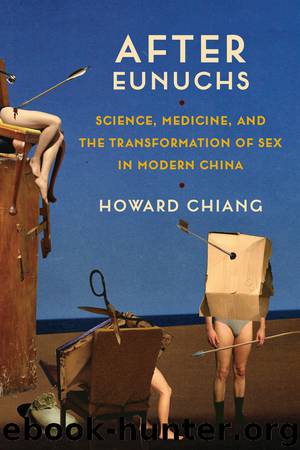After Eunuchs by Howard Chiang

Author:Howard Chiang
Language: eng
Format: epub
Publisher: Columbia University Press
Hermaphroditism as a Natural Anomaly
Escalated publicity on surgical attempts at changing sex, on top of a novel biochemical interpretation of the castrated body, led to a renewed interest in natural reproductive anomalies. To readers of the modern sexological literature, castration was an unambiguous case in point of human-induced alteration of sex. For centuries, however, Chinese physicians endorsed various perspectives on individuals born with ambiguous genitalia. The first systematic medical categorization of intersexed bodies appeared in the late Ming, with Li Shizhen’s listing of five “non-males” and five “non-females” in his compendium of material medica, Bencao gangmu (1596).75 As Charlotte Furth has suggested, Qing physicians for the most part adhered to, or at least systematically referenced, Li’s classification.76 As chapter two has shown, the situation started to change with the growing popularity of Western-style anatomical texts since the mid-nineteenth century. By the Republican period, Chinese life scientists readily filtered the competing perspectives and experimental findings on hermaphroditism—even on the microscopic scale of genes and chromosomes—from Europe and the United States.77
In the 1920s, though, some popularizers of sexology boiled down complex scientific theories for a general readership. Toward the end of his widely read ABC of Sexology, Chai Fuyuan included a chapter on “Abnormal Sexual Lifestyle” (畸形性生活, jixing xingshenghuo). The chapter focused on four topics in particular: “incomplete male growths” (男性發育不全, nanxing fayu buquan), “incomplete female growths” (女性發育不全, nüxing fayu buquan), “ambiguous genital sex” (男女性別不明, nannü xingbie buming), and “homosexuality” (同性戀愛, tongxing lian’ai).78 In the sections on incomplete male and female growths, Chai borrowed from Li Shizhen’s categorization to explain human reproductive anomalies in Western anatomical terms. On “incomplete male growths,” Chai wrote:
The incomplete growth of male reproductive organs is a phenomenon commonly known as “natural castration” (天閹, tianyan). There are several types of natural castration. The first type is characterized by the incomplete development of external genitalia. Even with fully functional testicles and the biological capacity to produce sperm, people with this condition cannot mate due to the small size of their penis. The second type is exactly the opposite: although people with this condition are physically capable of mating, they lack sexual motivation and the physiological ability to produce sperm. The last type is a combination of both: people with this condition have incomplete internal and external sexual organs. Internally, their bodies do not possess functional testes; externally, they have an immature penis.79
Chai laid out a commensurate discussion of “incomplete female growths”:
Women with an incomplete set of reproductive organs are typically called “stone maidens” (石女, shinü). The original meaning of “stone maiden” refers to women with genital anomalies of the sort that would make sexual penetration impossible. Eventually, the term was broadened to be associated more generally with incomplete female growths. With the external type, the genital organ is completely in an impenetrable state. It may be that the hymen is too thick so that it covers the vagina, or the labia is too thick and the vaginal opening too small making sexual penetration impossible. With the internal type, the
Download
This site does not store any files on its server. We only index and link to content provided by other sites. Please contact the content providers to delete copyright contents if any and email us, we'll remove relevant links or contents immediately.
Enlightenment Now: The Case for Reason, Science, Humanism, and Progress by Steven Pinker(7228)
A Journey Through Charms and Defence Against the Dark Arts (Harry Potter: A Journey Through…) by Pottermore Publishing(4781)
The Immortal Life of Henrietta Lacks by Rebecca Skloot(4525)
A Journey Through Divination and Astronomy by Publishing Pottermore(4344)
Elon Musk by Ashlee Vance(4028)
Origin Story: A Big History of Everything by David Christian(3648)
COSMOS by Carl Sagan(3554)
Alchemy and Alchemists by C. J. S. Thompson(3449)
Bad Pharma by Ben Goldacre(3355)
Enlightenment Now by Steven Pinker(3335)
Shadow of Night by Deborah Harkness(3302)
Inferior by Angela Saini(3276)
A Mind For Numbers: How to Excel at Math and Science (Even If You Flunked Algebra) by Barbara Oakley(3217)
Origin Story by David Christian(3147)
The Code Book by Simon Singh(3074)
Signature in the Cell: DNA and the Evidence for Intelligent Design by Stephen C. Meyer(3071)
The Elements by Theodore Gray(2998)
A Brief History of Time by Stephen Hawking(2960)
A Journey Through Potions and Herbology (A Journey Through…) by Pottermore Publishing(2826)
